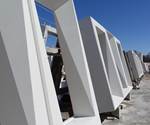Video: LSAM Speeds Production of Concrete Tooling
Thermwood’s dual-gantry Large Scale Additive Manufacturing (LSAM) 3D printer with CNC router printed and trimmed a large concrete tool with fewer setups.
Though becoming more controlled and predictable all the time, 3D printing remains a somewhat imprecise manufacturing method that gets near to net shape, but typically requires some kind of secondary processing to actually achieve net shape. Moving or setting up a part for secondary operations can be a challenge, one that is amplified on large parts such as a concrete form that was recently produced by Thermwood for the Domino Sugar Refinery development in New York City (read more about the 3D-printed concrete tooling used in this project here).
Thermwood is the developer of the Large Scale Additive Manufacturing (LSAM) system, a hybrid machine that combines polymer extrusion with machining capability, leveraging the company’s decades of experience in manufacturing three- and five-axis CNC machining centers. The machine features two gantries that operate independently, one with the print head and a compression wheel that helps fuse the layers together, and another with a CNC router. These combined capabilities make it possible to print the near-net shape part and then trim it to final size all on the same machine, even while another part runs. (Vinyl curtains make it possible to divide the system into different work zones, so that parts can be printed and trimmed simultaneously.)
“Even though we control our bead very, very tightly dimension-wise, you’re still dealing with a polymer that’s got some kind of shrinkage,” says Brent East, sales account manager. Given the imprecise nature of the part as 3D-printed, it can take hours to re-register a workpiece if it must be moved from the printer for finish machining. The LSAM system avoids the need to move the part at all, making it possible to trim the part in situ following printing, or to machine registration points in place before moving the part elsewhere (to another machine or to the LSAM’s second workzone) for machining operations, East says. Combining these operations reduces the setups and labor necessary to get to a final part.
For the concrete tool, this meant producing the form with just one additional setup to machine the underside of the tool after printing and trimming the first. Thermwood produced this tool at its Dale, Indiana, headquarters as a subcontractor for Additive Engineered Solutions (AES), one of the tooling suppliers to the concrete precaster on the project. Measuring 104 by 67 by 21 inches, the tool took 7 hours and 37 minutes to print from carbon fiber-filled ABS. Thermwood was able to machine the first side to final dimensions right on the build plate before flipping the tool over to finish the bottom.
Watch a timelapse of the printing and trimming process in the video below:
Related Content
-
What Is Neighborhood 91?
With its first building completely occupied, the N91 campus is on its way to becoming an end-to-end ecosystem for production additive manufacturing. Updates from the Pittsburgh initiative.
-
Additive Manufacturing Is Subtractive, Too: How CNC Machining Integrates With AM (Includes Video)
For Keselowski Advanced Manufacturing, succeeding with laser powder bed fusion as a production process means developing a machine shop that is responsive to, and moves at the pacing of, metal 3D printing.
-
How Norsk Titanium Is Scaling Up AM Production — and Employment — in New York State
New opportunities for part production via the company’s forging-like additive process are coming from the aerospace industry as well as a different sector, the semiconductor industry.

.jpg;width=70;height=70;mode=crop)












